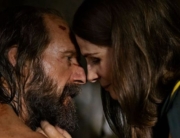One did not have to search far and wide for LGBTQ+ content at this year’s Toronto International Film Festival. On the contrary, gay characters popped up in half of the films I saw during the opening weekend (including Jennifer Lawrence’s role in Causeway.) In the Hollywood romcom Bros, one running gag features a terrifying rollercoaster ride at an LGBTQ history museum called the “traumacoaster.”
In another movie with a widely different tone altogether, Michael Grandage’s My Policeman returns to the repression of 1950s Britain, where sex among consenting men was illegal. The time period is depicted with sensitivity, nuance, and zipped-up emotions, with the muted colors typical of contemporary films set in the postwar era. The time line jumps back and forth between the era of harassment to the late 1990s. The gap of 40 years might as well be four centuries regarding the cultural/social changes. Yet oddly, the era portrayed onscreen with the more repressed, cryptic sentiments may not be the one you would assume would be the most understated.
Based on the 2012 novel by Bethan Roberts, the plot centers on a trio: a young primary school teacher, Marion; her boyfriend Tom, a new officer on the Brighton police force; and the erudite Patrick, a curator at the local museum, which has quite a treasure trove, including a JMW Turner. Indeed, cinematographer Ben Davis’s visual style owes much to the misty sunlit seascapes of the 19th century painter. The seascapes and the white cliffs of Dover, which feature in the 1990s section, have a deliberately painterly quality.
The young Tom (pop star Harry Styles) first encounters Patrick (David Dawson) when the dapper gentlemen reports a road accident, and sensing a curiosity in the young officer, the slightly older man offers the cop a private tour of the art gallery. Tom takes him up on the offer. Later, the bobby is so out of his element that he really believes Patrick is only interested in drawing a portrait of him when he arrives at the man’s well-furnished apartment after work at night. There, any sort of inhibited behavior goes out the window. Not only are their secret trysts the story’s central relationship, they become the most convincing one.
As a cover and for career advancement, Tom takes it upon himself to court and marry Marion (Emma Corrin, in a shapeshifting role), though Patrick warns him that would be unfair to her, although he’s also not fully honest himself. For Marion, Patrick is initially a friend and a benefactor, giving her and Tom a private tour of the museum and taking them to Covent Garden for La Traviata. Even after the couple are hitched, Patrick continues to play an intrusive part in their lives. The marriage certificate does nothing to tamper the men’s hormones.
However, it is not until 40 years later that Marion, now played by Gina McKee, realizes the full extent of the relationship between her husband and Patrick. Even so, she has agreed to care for an ailing Patrick, played in his golden years by Rupert Everett, after he has suffered a stroke. Yet her husband, Tom (now played by a diffident Linus Roche), refuses to look or to speak to him after their fraught falling-out decades earlier. He accuses his wife of taking Patrick into their home as a way of punishing him.
The narrative cuts back and forth between the eras, a constant form of contrast between the two Britains, pre- and post-sexual revolution. Between the two time periods, it is the younger cast that credibly adds depth to the complications of the entangled relationships. The film becomes more involving when these three are on screen, and Styles acquits himself well, oozing charm and naivety. It’s more than a credible performance. In only one (pivotal) scene are Tom’s actions unmotivated, but dictated by the narrative. Yet no one in the cast fully inhabit their roles too deeply.
Nonetheless, all of the characters, young and older, remain introspective even behind closed doors, as though the so-called British stiff upper lip was one of the reoccurring directions for the cast. They don’t completely let themselves go, apart from Tom and Patrick in the bedroom. Except for the scenes of sexual gymnastics, the adaption lacks an edge, and the resolution leads to a soft landing. With the exception of Everett, who remains mostly incommunicative because of the stroke, Roach and McKee genteelly inhabit their roles almost as if they were in a Terence Rattigan drama from the early 1950s. Yet, when one revisits the British New Wave of the late 1950s and 1960s, one will see that underneath the more formal sense of behavior, actors were stripped bare, figuratively, in a wide range of works, such as The Entertainer or Victim, the groundbreaking film that addressed the criminalization of gay men, starring Dirk Bogarde.
Instead, Grandage guides his cast in the current mode of keeping it cool, though one wishes that he had borrowed more inspiration from British cinema of the not-so-long-ago past. Still, despite the overall unevenness, the script retains the bones of a compelling story of betrayal. (Full disclosure: Any film that includes Ella Fitzgerald’s cover of “Bewitched, Bothered, and Bewildered” will always find a place somewhere in my heart.)
My Policeman will open theatrically on October 21 and begin streaming on Amazon November 4.







Leave A Comment